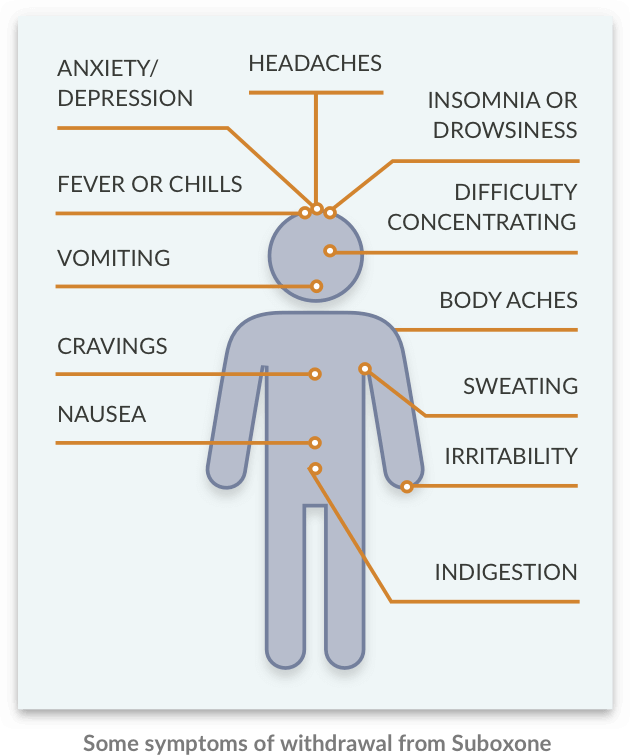Suboxone Withdrawal Process Symptoms and Timeline
The United States is in the depths of one of its worst drug epidemics the nation has ever experienced. In 2019, an estimated 10.1 million people aged 12 or older misused opioids. Specifically, 9.7 million people misused prescription pain relievers and 745,000 people used heroin. (2) Though efforts to slow this epidemic have not gone unnoticed, it’s clear that many Americans find themselves under the opioid crisis grip. Many different techniques have been implemented to defuse this deadly fire that is opioid addiction and opioid overdose. These include treatment centers, detox facilities, twelve-step programs, group counseling, drug awareness education, faith-based programs, and therapy.

Some of these techniques focus on the psychological side of drug addiction, hoping to bring a user to an awareness of why they abuse drugs. Other techniques push addicts to believe in a power greater than themselves to be rid of desires and urges for drugs. And other techniques try to attack the physical dependency of a body hooked on a narcotic, slowly weaning a user’s body off an opioid by using a synthetic version of an opioid. There are many different drugs used in this weaning off process, such as methadone or naltrexone. There is another drug called suboxone. But what exactly is suboxone? How long is suboxone withdrawal? How long is suboxone withdrawal compared to other drugs like methadone? What does suboxone withdrawal look like day to day?
What Is Suboxone?
Suboxone, which contains the drugs Buprenorphine and naloxone combined, is a medication that works in the brain to treat opioid use disorder. The Buprenorphine mix is the active drug in buprenorphine/naloxone. (2) Buprenorphine works as a partial opioid agonist, which means that it tricks the body into thinking it is an opioid to the same level of heroin or methadone, which are considered full on opioids, or full opioid agonists. The National Alliance on Mental Illness goes on to describe Buprenorphine as having “a ‘ceiling effect’ so the opioid effects level off even with further dose increases which reduces the risk of misuse, dependency, and side effects.” (3) This means that even if a user needs to take more Buprenorphine, they will not feel the “high” that usually comes from taking more of a substance.
Buprenorphine also lowers the harsh opioid withdrawal effects, cutting down a user’s craving for opioids. Other weaning off processes, such as methadone, sometimes leave the user addicted to the very drug (methadone) they are using to get off harder drugs (heroin). Buprenorphine tries to eliminate this problem. The NAMI describes naloxone as an opioid antagonist or “blocker”. Naloxone is taken as a tablet, and not to be injected intravenously. If it is taken intravenously, it will make someone who is dependent on opioids have very uncomfortable withdrawal symptoms. The act of taking naloxone through the mouth and having negative consequences if taken intravenously will hopefully deter addicts from shooting the Suboxone. The suboxone process does not happen overnight, but it has proven effective. For those in the depths of an opioid addiction, you might be wondering how long is suboxone withdrawal?
How Long Is Suboxone Withdrawal?
Determining how long is suboxone withdrawal isn’t going to be exact for everyone. Factors such as how long the user has been using and their overall health come into play. Suboxone can sometimes be used for a long period of time after an addict has stopped taking other opioids. According to American Addiction Centers, Suboxone withdrawal symptoms can last for as long as a month. In some cases, psychological dependence can withstand for a while, even if physical cravings have been alleviated. During days 1, 2, and suboxone withdrawal day 3, symptoms are at their worst. Suboxone withdrawal day 3 is when physical symptoms are felt most. Some symptoms that can be felt during suboxone withdrawal day 3 are:
- Nausea and vomiting
- Muscle and body aches
- Fever or chills
- Sweating and Headaches (4)

Psychological symptoms that can be felt during suboxone withdrawal day 3 are anxiety, depression, and irritability, however most psychological symptoms are felt after suboxone withdrawal day 5. Some users will experience these symptoms through the hours of suboxone withdrawal day 3 harsher than others. This depends on how long the user has been on suboxone, and the dosage taken as well. After suboxone withdrawal day 3, users start to feel fewer physical symptoms, but more psychological symptoms come about. After suboxone withdrawal day 5, body aches, headaches, and insomnia are left over from the previous 72 hours. Psychological symptoms after suboxone withdrawal day 5 are mood swings and physical cravings.
Check Your Insurance Coverage for FREE
Find out if your insurance covers addiction treatment in minutes. We accept most insurance!
But the biggest psychological symptom to be dealt with after suboxone withdrawal day 5 is depression. This is when it is most important for those going through withdrawals to stay diligent with maintaining their medical attention. After suboxone withdrawal day 5 is the most vulnerable time for users, and the most likely time they will relapse. Even though physical cravings subside a month or so after suboxone withdrawal day 5, psychological cravings can still linger for some time, even for months. So how long is the suboxone withdrawal process? It’s a case-to-case answer, but in general, it can last from 2 weeks to several months.
Reach out to Hotel California by the Sea
We specialize in treating addiction and other co-occurring disorders, such as PTSD. Our Admissions specialists are available to walk you through the best options for treating your addiction.
If you are curious about how long is suboxone withdrawal because you or a loved one are currently about to undergo suboxone doses, it’s important to note that relapse may happen. If you do experience a relapse, it’s important to note that this doesn’t mean you can’t try suboxone treatment again. After treatment is completed, users should stay in contact with medical professionals, seek counseling, and join group therapy or 12 step-communities to help deal with the possible cravings that still linger.
References:
- https://www.hhs.gov/opioids/statistics/index.html
- https://www.nami.org/About-Mental-Illness/Treatments/Mental-Health-Medications/Types-of-Medication/Buprenorphine/Buprenorphine-Naloxone-(Suboxone)
- https://www.nami.org/About-Mental-Illness/Treatments/Mental-Health-Medications/Types-of-Medication/Buprenorphine/Buprenorphine-Naloxone-(Suboxone)
